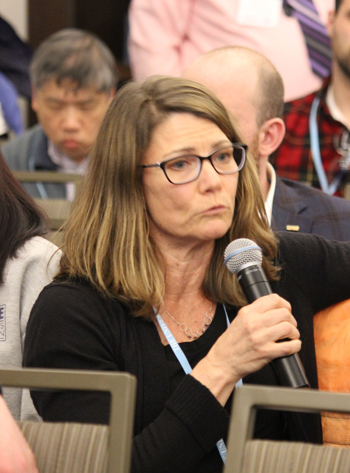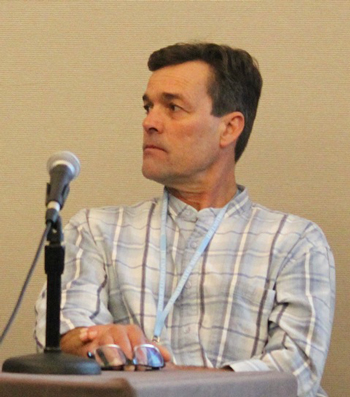U.S. and Canadian Lobstermen Meet to Exchange Information and Ideas

Patrice McCarron, MLA. Although not on the agenda the whale rope lawsuit drew a lot of discussion. Fishermen’s Voice photos.
Lobstermen gathered in Portland on April 5th and 6th to discuss their fishery. Maine and Canada are the major sources of American lobster. There are similarities and differences in the two country’s lobster industries and some of them were brought up at this year’s meeting. The meetings alternate between Portland and St. John, New Brunswick, Canada.
There were more than 225 attendees registered for the meeting. Fishermen, scientists, lobster dealers and fisheries managers from both countries attended the 15th annual event organized by the Lobster Institute at the University of Maine.
Topics ranged from prices, to whales, handling, markets and bait. Canadian lobstermen spoke more about prices than U.S. lobstermen. One Canadian lobsterman said all costs associated with lobster fishing had gone up in the last five years. But he said lobstermen have not seen an increase in the price they are paid. Scout Wuerthner of Inland Seafood said, “We are seeing all the same cost increases.” He went on to say that among the forces that drive the price paid for lobster is the effect on price “when someone (presumably a dealer) has a surplus of lobster and drops the price to get rid of it, that becomes the new price of lobster.”
There are many effects
that can reduce
profitability and cause
the price to the
customer to rise.
– Stewart Lamont,
Tangiers Lobster Company,
Nova Scotia
When someone said, “We need to ask our customers to pay a little more,” it drew applause from the room. Annie Tselikis, Maine Lobster Dealers Association, offered in response that rather than expect the customer to pay more that the customer be offered something that is recognized as valuable.
The topic came up in the session on improving the handling of lobster to deliver a better product to the consumer, reduce shrinkage and ultimately increase price for dealers and lobstermen. “Shrinkage can undermine price and markets,” Wuerthner said. When lobster are held for long periods they are not dead but can be nearly empty of meat, he said. Regarding shrinkage Wuerthner said, “You (lobstermen) get paid for 100% of what you catch, we get paid for 95% of what we buy,” due to shrinkage.
Stewart Lamont, Tangier Lobster Company, Nova Scotia, said, “there are many effects that can reduce profitability and cause the price to the customer to rise. One result of this can be that restaurants de-list lobster from their menu.” Lamont called for transparency in the industry.

Marc Nighman. His co-op now washes out crates to get rid of bands, broken lobster parts and debris.
Improving techniques for handling lobster from the time it is hauled to when it is shipped to consumers has been discussed among fishermen, scientists and dealers more often over the last few years. As lobster markets change and expand, consumer demands have been changing. The live lobster markets in Asia may be the single most demanding for high standards in handling. Only the most robust lobster will arrive alive after the many environmental changes from the trap on the bottom to a kitchen on the other side of the globe.
Mark Nighman from the Cranberry Islands Fishermen’s Co-op said their coop was addressing handling, lobster inventory assessments and the conditions in which they handle lobster at their coop. He noted that plastic debris in the water around the coop, in the building and in the lobster crates has been cleaned up. They now wash out crates to get rid of bands, broken lobster parts and debris. He said fishermen participate in these efforts because it is their coop.
The federal government
is demanding that
the “lobster industry
meet goals that are
not achievable.”
– Patrice McCarron, MLA
The discussion of bait in the context of the coming 2019 bait shortage went directly to alternative baits, non-fish baits and composites. The possibility of Asian carp from the midwest arriving in time for the lobster season was considered a possibility. Carp is a native to the U.S., but not this variety. Hide bait alternatives, pig hide — a more recent arrival on the market which some fishermen said they were using — and cowhide were options discussed. All baits were expected to be more expensive this year. Fish processing wastes packed in a kind of paste was another option.
One Canadian lobsterman mentioned the large number of seals in Canada and the U.S. He suggested seals might be used for lobster bait. He was quickly reminded of the United States Marine Mammal Protection Act. It is a law, said Tselikis, that the U.S. enforces and can use to ban imports from countries that do not enforce protection of marine mammals. Therefore the U.S. could not import Canadian lobster if they used seal for bait. It was a correction that drew applause from the room.

Charlie McGeohagen, PRI. Charlie briefly wondered if seals could be used for lobster bait, until he was read the MMPA. Canada doesn’t have one. Fishermen’s Voice photo.
Although it was not on the agenda, marine mammal protection was an important topic on both days. Specifically the protection of whales and in particular the northern right whale. Canada does not have a marine mammal protection act. Rare in the Gulf of St. Lawrence before 2017, more northern right whales have been going into Canadian waters in recent years, primarily into the Gulf of St. Lawrence. Copepods are the right whale’s primary food source and warmer waters are changing where this food supply can be found.
The lawsuit against the National Marine Fisheries Service regarding rope entanglements of the northern right whale, which is protected under the MMPA and listed as endangered under the Endangered Species Act, was discussed at length. The Maine lobster industry is under considerable pressure to find a way to reach an agreement with the federal government that does not require lobstermen to remove the vertical lines that mark their trap locations with buoys. Maine Lobstermen’s Association Executive Director Patrice McCarron said, “We cannot meet their standards.” The federal government, she said, is demanding that the “lobster industry meet goals that are not achievable.”
Canadian fishing gear is believed to be the source of some of the rope found on entangled right whales in the Gulf of Maine. Canada is beginning to address whale entanglements and whale ship strikes, although it does not have a similar mammal protection law driving their efforts.
